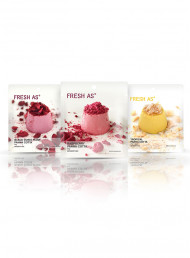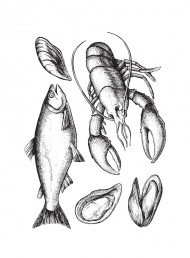A guide to: berries

Nothing says summer like berries – Sarah La Touche looks at how to get the best from these seasonal delights.
It would be hard to imagine a summer without berries; little jewels of intense colour, ripe flavour and delicate perfume, they shout health and festivity.
Their true seasons are spring through to summer, but berries can be found year round now frozen and dried or occasionally freeze-dried. Some respond better than others to different preserving methods. Cranberries, for example, freeze and dry well because they contain high levels of phenolic compounds that help give the fruit its distinctive colour, flavour and perfume. Their level of acidity and antimicrobial qualities help too. Raspberries and strawberries on the other hand, although high in acidity and phenols are plumped up with water because of their different cell structure, making them far more fragile and susceptible to damage.
These different structural qualities, flavour profiles and textures are the very things that tell us how to use berries in our cooking.
Blackberries – with needle-sharp thorns and clusters of plump black fruit, blackberries ripen at the height of summer, following on from raspberries. They grow in drupelets, (the individual parts which form the fleshy aggregate fruit), similar to raspberries, with both unripe and ripe fruit appearing in the same bunch. The wild blackberry is often the sweetest and most perfumed but there are many hybrid and thornless varieties available now for keen gardeners. Blackberries are best eaten freshly picked, still warm from the sun and with fresh pouring cream. They make excellent jams or conserves, sweet pies and tarts, toppings for meringues or pavlovas, and delicious wine, cordial or Ratafia (a type of aperitif liqueur), as well as tasty purées. They are high in vitamin C, dietary fibre and packed with antioxidants. If you collect wild blackberries, know your hedgerows – check with the local council
to be sure they haven’t been sprayed.
Blackberries won’t keep fresh for long and as with most berries are susceptible to mould. They do freeze well but will go mushy when thawed so are best for jams, jellies and coulis. Lay them on a tray lined with baking paper to freeze then transfer to an airtight plastic bag and store for three to six months.
Blueberries – this small bluish-black berry with its appealing mix of sweet and tart is an edible delight. Blueberries will keep for about ten days in the refrigerator and freeze beautifully, holding their shape thanks to their firm skins. They are a plentiful source of antioxidants and great for snacking on or popping into school lunchboxes. They are delicious in tarts, served with ricotta or plain pancakes, mixed with plain yoghurt or with other berries for breakfast, and dressed up for dessert with mascarpone, ricotta or cream. Watch out for changes in colour and staining when making muffins or cakes using baking soda.
Boysenberries – a hybrid developed in the USA when the blackberry, loganberry, and it is believed, the raspberry were crossed. At its best between December and February, this slightly elongated fruit has a vibrant, deep purple hue and delicate velvet texture. When ripe it is sweet and succulent and, like blackberries, raspberries and strawberries, doesn’t keep for long but can be frozen and used for making jams, sauces, ice cream, sorbet, and in flavouring egg custards or panna cotta.
Cranberries – cranberries go bright red when ripe and can be harvested wet or dry from late summer through to autumn. In recent years they were best known as
a traditional American accompaniment to roast turkey at Thanksgiving. Now they are widely available dried, to eat as is or to add to a range of baking, sweet and savoury foods. Sweetened cranberry juice has also become popular, especially when added to cocktails and punch. Cranberries are very tart, containing almost as much acidity as lemons and limes and are high in pectin. This is why cranberry sauce thickens so rapidly even with minimal cooking. It also means the fruit lasts well dried, making them a perfect choice to add to muesli, snack bars and baked goods. Try adding a cup of dried cranberries to your Christmas cake or pudding along with currants and taste the difference. They are rich in a natural preservative called benzoic acid, often found in prepared foods these days, used to prolong shelf life. Other attributes include antimicrobial properties making the unsweetened juice an effective, proven deterrent for warding off urinary tract infections.
Currants – these tiny berries grow in a variety of colours: red, white and black, and depending on the variety, are harvested from October through to March. Traditionally they are used dried in fruitcakes, Christmas puddings and mince tarts, providing a deliciously intense, spicy sweetness so synonymous with Christmas baking. When fresh they are loaded with pectin and deep, rich flavour – excellent qualities for making jellies, jams and coulis for topping cakes or desserts. They pack an impressive punch sweetened and made into sorbet, ice cream or granita served on a hot summer day. Blackcurrants have long been used to make vitamin C-rich cordials, and in Europe, they are used to flavour wines and liqueurs like the famous Crème de Cassis from Bourgogne. With their plump, ripe skins they are ideal for freezing: simply wash and spread on a tray to freeze, then pack into containers once frozen. They will last for up to six months.
Elderberries – these tiny, dark berries grow on the elder bush, or tree, which boasts sprays of pretty white flowers in spring. The flowers are delicious steeped and made into cordial, aperitif wine or that famous English summer tipple, Elderflower Champagne. They make an original dessert too, dipped in a light batter then briskly deep-fried, drained and sprinkled with castor sugar. The French refer to this as a ‘beignet’ and they must be eaten straight away, warm and crisp. The aromatic berries contain lectins, sugar-binding proteins that inhibit nutrients from being absorbed during digestion, so the berries are best cooked to break these down before the highly perfumed juice is turned into syrups, cordials or wine. Elderberries make fine jam or jelly too.
Gooseberries – a cousin to the currant, gooseberries fell out of fashion for many years, possibly because they are so tart, but are now making a comeback. With their attractive, green to blush-pink translucent fruit they make beautiful jams and tarts. They can be picked green for extra punch, or stewed lightly with sweet apples or other berries for filling buttery pastry to create an extraordinary tart. Once ripened they have an attractive pinkish tinge – poach them gently with sugar or honey and serve them simply as is, or fold through some sweetened vanilla-flavoured whipped cream to make Gooseberry Fool. Gooseberries will freeze and hold their shape well, but are best cooked or made into conserve once thawed. Cape Gooseberries (also known as Physalis, or ground berries) may have a similar name, but are a totally different fruit. A native of South America, they grow like a weed in milder regions of New Zealand. The berry itself is sunshine yellow and smooth skinned, encased in a veined parchment-like lantern, which turns from green to papery, pale yellow once ripe. The fruit is delicious fresh: tangy, sweet-tart and perfumed. Poaching or stewing with apples or pears enhances its delicate fragrance. Honey and ginger are natural partners and this fruit makes fine jam.
Loganberries – a cross between a blackberry and a raspberry, although they look more like an elongated, dark red blackberry. Like blackberries, raspberries and boysenberries these are a member of the caneberry or bramble family. We don’t see them a lot in New Zealand, but they are deliciously sweet and succulent, and occasionally you will find them around Christmas time. If so, pop them in the Christmas trifle or fruit salad. They don’t need cooking but will make scrumptious crumbles, pies and syrups. In North America they are made into a popular juice similar to cranberry juice.
Mulberries – a hard-to-find berry in New Zealand, but well worth looking out for. Mulberries grow on a handsome tree which, when mature, makes a beautiful shade tree. The fruit is most commonly dark black-red but can also be white or red. White Mulberry trees were cultivated extensively in Southern Europe in the 18th century to feed silk worms for the silk trade. The fruit resembles a boysenberry with their elongated shape and juicy flesh – sweet, soft, and aromatic. A cold climate lover, they will fruit from December through to February and make a fruit tart worth walking miles for. Rich in vitamins, magnesium, iron and fibre they won’t keep for more than a few days and even freezing is tenuous as they are so delicate and turn to mush easily. Eat them straight from the tree if you can, juice them, make purées
for spooning over ice cream or custard, flans or charlottes, and jam. Be sure to wear gloves while preparing the fruit as it stains everything.
Raspberries – possibly the Queen of all berries and easy to grow in your own garden. Raspberries are another of the caneberries and can fruit as early as October through to April depending on the variety. Firm, plump and fragile, the fruit may be dark ruby-red, yellowy-golden and slightly rounder, or most commonly, conical-shaped and a true framboise, pinky-red.
Raspberries exude a sweet, heady scent with a sweet flavour. The tiny European wild version is even more delicate. The berries perish easily and are susceptible to mould so eat them as fresh as possible. Use for decorating cakes or desserts, or make them into a fragrant sauce to serve with pastries. Raspberries make splendid jam, unbeatable for serving with fresh scones, warm croissants or pancakes. Arrange them on tarts over crème pâtissière, make delicious purées to construct a charlotte set with sponge fingers or to enjoy with egg custards like crème anglaise or crème brulée. They make excellent syrups, compotes for the breakfast table and work wonderfully with all kinds of chocolate creations. Raspberries can be frozen but will turn mushy on thawing.
Strawberries – the most popular and accessible of all the berry fruits, with a season that spans October to March thanks to the abundant varieties grown here like Tioga, Red Gauntlet and Camarosa. Strawberries can be grown in pots on your deck or in the garden. They are immensely rewarding and fun, especially for children with green fingers. The biggest problem is making sure you get to them before the birds do. Pick them as soon as they ripen and are fragrant, and eat fresh with rich cream, using the imperfect fruit for
making jam.
Refrigerating strawberries will lengthen their shelf life, but diminish their flavour and perfume, so always serve them at room temperature when fresh.
Strawberries make a great addition to fruit salad, or can be cooked to a sauce for Summer Pudding, cooled and mixed with other fresh berries like raspberries, boysenberries and small whole strawberries. Strawberry purées can be folded into crème anglaise to flavour ice cream or made into syrup to create a delicious fresh sorbet. They reign supreme on a light, fluffy sponge or pavlova, or with numerous other desserts, cakes and pastries. They don’t freeze well, and will go mushy when thawed, but will retain their flavour. If you want to keep them whole for freezing, try dipping them in water, then sugar before placing them on a tray to snap freeze. Once frozen place them in a freezer container with firm sides so they keep their shape. Alternatively, you can make a pulp with the fruit before freezing it.
Storing Berries
Always choose berries that are plump and richly coloured. Unlike other fruits and vegetables, berries don’t continue to ripen once picked. Avoid any fruit that is crushed, bruised or showing any signs of mould, and always smell them. Distinct fragrance is an excellent sign of freshness.
Any kind of moisture and heat will encourage spoilage so keep your berries in the lower part of the refrigerator uncovered, and rinse them just prior to using them. Strawberries and blueberries in particular retain high levels of chemical sprays so opt for organically grown berries where possible and always wash them carefully before eating them.
To freeze – wash and dry the berries carefully straight after harvesting. Arrange them in a single layer on a tray lined with baking paper or paper towels to take up any extra moisture. Freeze as quickly as possible until they are solid before transferring them to a freezer bag or box for storage. Most berries will keep for three to six months.
Freeze-dried – most berries can be freeze-dried, a process where the fruit is dehydrated in stages by removing their water content under pressure. It is a complicated process but effective. The fruit can then be stored at room temperature and reconstituted when required. Freeze-dried berries are used in many breakfast cereals or ground to a powder for use in commercial foods like biscuits, cakes, ice creams and confectionery. As with normal freezing, the berries’ vitamins and nutrients are retained along with the colour and aromas.
Dehydrating – berries also can be dried in a slow oven moderately successfully at home, and also in a domestic dehydrator. Once dried, they do need to be kept airtight to avoid spoilage from mould. Add them to homemade breakfast cereals, muffins and cakes or ice creams and sorbets, bavarois and mousses.
latest issue:
Issue #120
As the days become shorter, and the nights cooler, the latest issue is perfectly timed to deliver delicious autumn dishes. From recipes using fresh seasonal produce such as feijoas and apples, to spectacular soothing soups and super-quick after-work meals in our Food Fast section, we’ve got you covered. With Easter on the horizon, we feature recipes that will see you through breakfast, lunch and dinner over a leisurely weekend holiday, and whip up chocolatey baking treats sure to please. We round up delicious dinners for two and showcase a hot new Korean cookbook before heading south to Dunedin to check out all that’s new in food and dining.The latest issue of dish is on sale NOW at all good bookstores and supermarkets – don’t miss it!





